You are here
Country Margush.
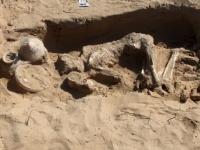
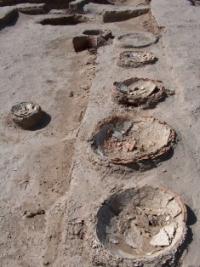
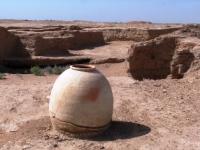
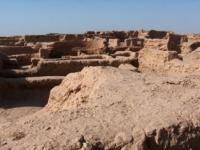
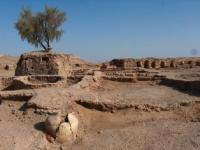
Travel in vicinities of ancient Merv.
“Ancient builders used for that purpose specially made ceramic tubes (up to half a meter long) which being closely put one into another were buried under the floor and served to drain water out of the palace and the kremlin. In the 3rd millennia ВС simple runoff ditches covered from above with bricks (and quite often with big fragments of broken ceramics) were used for that purposes and special drainage systems were built only in isolated instances in the biggest palaces and temples as, for example, in the famous palace in Mari on Euphrates (modern Syria)”
Walk on ancient settlement Gonur depe.
We shall commence a brief review of the Margush capital principal buildings with its central palace and in order to see it more clearly let's take hypothetical visitor of antiquity as an assistor, fancying him coming slowly near to the kremlin and the palace, already raised by that time, by a dusty road at the end of the 3rd millennia ВС.
At first, only shapeless contours of outer encircling wall of the whole "king's town" had appeared on the horizon, and then defensive walls of the kremlin which were additionally strengthened with rectangular fortification towers.
Coming nearer, a visitor could see not only general outline of the palace but also arrow-shaped open embrasures of the outer defensive walls threateningly menacing with arrows of palace guards. If we get a bird's eye view of the palace we can see that it had irregular trapeziform by its lay-out with general dimensions 125 x 120 meters.
Such unusual configuration became a result of some miscalculations made by builders when dimensions of the so-called administrative complex, situated in the south-east corner of the kremlin, had exceeded suppositional bounds and as a consequence builders had to lengthen eastern facade wall.
Rectangular towers are situated in fours along the external perimeter of three facade walls at the same distance from each other and there are passages leading inside the kremlin between two pairs of them. The eastern facade wall, which was the longest one because of the above-mentioned miscalculation made by builders, is an exception of this rule.
At first, it had also had four towers but later on, after heavy fire had occurred, in which palace had been destroyed, the fifth additional tower was built on to it, that was made first of all with a view to reinforce kremlin's defensive potential.
All towers of kremlin walls have passages (with a height of about 170 meter from floor to lintel, being 70 - 80 centimeters wide) leading into the inner corridor which takes in the kremlin's inner part from all four sides.
There are intraparietal hearths always set up inside the kremlin wall in each tower without exception. It follow that all of them were designed by ancient architects in advance. Large vessels of pithos type and quite often smaller ones, usually used for household purposes, stood in some of the towers right on the floor near such double-hearths.
By their complex construction these double-hearths were characteristic most of all for the premises of special, most probably cult purpose, but it is difficult to say right now why these hearths are situated practically in all towers of the kremlin's external walls.
Some time passed after heavy fire had occurred, kremlin's external walls began to dilapidate little by little, that is why all of them were "covered in" brick sheath along the external perimeter and additional brick counterfort was constructed on the northern side (where main entrance to the kremlin was situated), specially splayed outwards, that would present additional difficulties in case of possible attacks undertaken by enemies.
Not being content with these security measures, aimed at strengthening of the complex defensive capability, builders erected pre-gate construction, in the form of two walls going towards each other with a narrow pass between them, directly in front of the kremlin's main gate.
This construction had to make seizure of the kremlin by possible enemy as much difficult as possible. And though we don't know exactly what enemies rulers of the ancient Margush country were afraid of we can assert that they had forcible arguments for these apprehensions.
Traces of great fire inside the kremlin and the palace, resulted in their destruction by fire, after which town stayed in desolation for a long time, witness to some devastating disaster. The palace and the kremlin were rebuilt only after many years and abovementioned restoration works aimed at strengthening of defensive capability of the whole monumental complex were conducted.
But let's return to our visitor. Having come near to the kremlin, he entered inside through very narrow (only one meter wide) main entrance and found himself on a small, in a sense, "palace square" on the other side of which there was the palace.
Two "residential areas" consisting of usual living quarters where palace servants and kremlin guards might have lived are situated on the right and on the left of a visitor standing on empty palace square. There are particular premises among this suite of living and economic "blocks", they are distinguished with regular, rectangular configuration and, above all, with presence of "blind windows" or peculiar altars and double-hearth where sacrificial meat for every-day sacrifices was prepared.
We may surmise that rooms of this kind served as original "home sanctuaries" in which king's servants performed every day prayers accompanied with sacrifices and probably cult libations. Ancient visitor, standing in the middle of "palace square", knew, undoubtedly, much more about the kremlin and the palace than we do, but possibly he could not know that quite complicated, for that time, drainage system arranged to take off rain water, that might accumulate during heavy showers on "palace square", outside the kremlin was under his feet.
Ancient builders used for that purpose specially made ceramic tubes (up to half a meter long) which being closely put one into another were buried under the floor and served to drain water out of the palace and the kremlin.
In the 3rd millennia ВС simple runoff ditches covered from above with bricks (and quite often with big fragments of broken ceramics) were used for that purposes and special drainage systems were built only in isolated instances in the biggest palaces and temples as, for example, in the famous palace in Mari on Euphrates (modern Syria).
Exactly the same system was constructed in the Northern Gonur kremlin that puts it on the level of the most advanced centers of that time.
Authority:
Gonurdepe. City of Kings and Goods. Victor Sarinidi. Ashgabad. Miras. 2006.
Photos
Alexander Petrov.







